UPSC Daily Current Affairs- 4th November 2023 | Current Affairs & Hindu Analysis: Daily, Weekly & Monthly PDF Download
GS-I
Taurid meteor showers
Subject: Geography
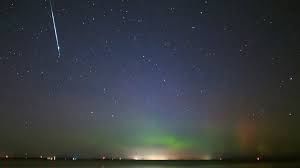
Why in News?
A celestial light show will grace the night sky as the Taurid meteor shower reaches its peak.
About the Taurid meteor shower:
- Taurid meteors result from the periodic Comet 2P/Encke, which holds the shortest known orbital period for a comet, completing a trip around the sun in just 3.3 years.
- These meteor showers are named after the Taurus constellation.
- They consist of two distinct streams – the Southern and Northern Taurids – which have gradually spread due to the gravitational pull of Jupiter.
- Visible to the naked eye, the best viewing time is around midnight.
- While they are considered modest, they typically yield fewer than 10 shooting stars per hour during peak nights.
- November stands out as a favorable month for meteor watching, as it brings a high number of sporadic meteors.
What are Meteoroid, Meteor and Meteorite?
- A meteoroid is a celestial object that varies in size, spanning from tiny dust particles to small asteroids.
- When these meteoroids plunge into the Earth's atmosphere or the atmosphere of another planet, such as Mars, at high velocities, they create luminous phenomena known as meteors or "shooting stars."
What is the significance of Meteors?
- This process assists in gaining insights into the early conditions and events that shaped the history of the solar system.
- These insights encompass critical factors such as the age and composition of various celestial bodies that played a role in planetary formation.
- It also enables us to determine the temperatures experienced on the surfaces and within asteroids, shedding light on their thermal history.
- Additionally, it helps in assessing the extent to which materials have been altered or impacted by past collisions and shock events.
Source: Live Science
The world is getting older. Can India cope?
Subject: Social Issues
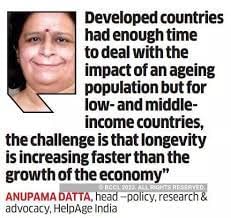
Why in News?
India is becoming the most populous country soon, but it’s also aging rapidly. This brings challenges like fewer workers and a changed global role. To tackle this, we need plans for more kids, strategies for the elderly, and preparations for India’s new place in the world.
Key Highlights:
- India is on track to overtake China as the world's most populous country by 2027.
- Globally, there is a prevailing trend of population aging, leading to an increase in the number of elderly individuals.
- In India, the elderly population is projected to double by 2050, making up around 20% of the total population.
- Declining fertility rates are observed in both developed and developing nations, influencing the old age dependency ratio.
- The world is undergoing a significant geopolitical transformation, with India, Nigeria, China, and the United States forecasted to emerge as dominant global powers by the year 2100.
Challenges and Concerns:
- Aging populations result in a reduced labor force and fewer taxpayers, which can have a detrimental effect on a country's capacity to generate wealth.
- Decreasing fertility rates create economic obstacles, particularly in developing nations such as India.
- The increasing size of the elderly population carries noteworthy consequences for healthcare systems, the economy, and societal structures.
- It is worth noting that developed countries tend to experience a boost in per capita income as their populations age, unlike developing nations like India.
- A possible population decline in India by the end of the century might have repercussions for its geopolitical status.
Analysis:
- The article highlights the significance of acknowledging and tackling the challenges brought about by aging populations and reducing fertility rates.
- It underscores the essentiality of adopting comprehensive strategies to effectively manage the economic and societal consequences resulting from these demographic changes.
- The geopolitical shift mentioned points towards a transformation in power dynamics, where factors such as immigration and reproductive rights assume pivotal roles in reshaping the global landscape.
Key Data and Facts:
- India is projected to experience a substantial 41% growth in its elderly population between 2021 and 2031.
- The percentage of older individuals in India will double to reach 20.8% by 2050, with a total of 347 million elderly residents.
- In urban India, fertility rates have become comparable to those of developed countries, standing at 1.6.
- By the year 2100, China is expected to witness a significant decline in its population, which could impact its geopolitical influence.
- The anticipated population decline in India and the substantial increase in the senior citizen demographic present formidable challenges for the nation.Way Forward
To counter declining fertility rates, policymakers should implement measures that promote work-life balance, provide accessible childcare, and support reproductive choice.
Developing comprehensive strategies is essential to address the economic and healthcare challenges that arise with an aging population.
When considering demographic shifts, it's crucial to anticipate the geopolitical implications and plan for a future in which India holds a significant role on the global stage.
Acknowledging the impact of immigration and reproductive rights for women is pivotal in shaping the global power structure.
A holistic approach to demographics should be encouraged, taking into account not only societal and economic aspects but also the geopolitical factors that contribute to a nation's influence and standing in the world.
Source: Indian Express
GS-II
ENCORE software
Subject: Polity and Governance

Why in News?
The Election Commission of India has designed in-house software, ENCORE, for complete Candidate and election management.About ENCORE software:- The ENCORE software is an acronym for Enabling Communications On Real-Time Environment.
- This software offers a seamless platform that aids Returning Officers in handling various election-related processes, including candidate nominations, affidavits, voter turnout, counting, results, and data management.
- The ENCORE counting application serves as a comprehensive tool for Returning Officers, enabling them to digitize the recorded votes, tabulate data round by round, and generate statutory reports pertaining to the counting process.
- Additionally, the ENCORE Scrutiny Application provides Returning Officers with the capability to scrutinize online the nominations submitted by candidates. This involves verifying and categorizing the nomination status as Accepted, Rejected, or Withdrawn, facilitating the preparation of the final list of contesting candidates and symbol assignment.
Key Facts about the Election Commission of India
- The Election Commission of India (ECI) is a permanent constitutional body entrusted with the responsibility of organizing free and fair elections within India.
- The Indian Constitution bestows the ECI with the authority of direction, superintendence, and control over the conduct of elections for Parliament, state legislatures, the President of India, and the Vice-President of India.
Functions of the ECI:
- Determination of Electoral Constituencies: The ECI is responsible for delineating the territorial areas of electoral constituencies across the country.
- Preparation and Revision of Electoral Rolls: The Commission regularly prepares and updates electoral rolls, ensuring the registration of all eligible voters.
- Notification of Election Schedules: The ECI announces the schedules and dates for elections and conducts the scrutiny of nomination papers.
- Recognition of Political Parties: The Commission grants recognition to various political parties and assigns them election symbols.
- Advisory Role: The ECI also possesses advisory jurisdiction regarding the post-election disqualification of incumbent members of Parliament and State Legislatures.
Composition:
- The ECI comprises three members: a Chief Election Commissioner (CEC) and two Election Commissioners (ECs).
- The President appoints the CEC and other ECs based on the advice of the Union Council of Ministers, led by the Prime Minister.
- The Indian Constitution does not specify any academic or other qualifications for these appointments.
- The tenure and conditions of service for all Commissioners are determined by the President. Their tenure is typically 6 years or until they reach the age of 65, depending on whichever occurs earlier.
- The CEC and the two ECs enjoy similar powers and receive emoluments, including salaries, that are equivalent to those of a Supreme Court judge.
Source: AIR
Israel-Hamas War: Is Russia benefiting from the conflict?
Subject: International Relations
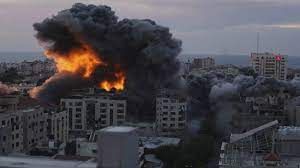
Why in News?Russia’s official stance on the Israel-Hamas conflict places blame on the US for the actions of the militant Islamist organization Hamas.Russia’s Interests and Official Position- Friendship and Disappointment: Russia had hoped for support from Israeli PM in the Ukraine conflict. When Israel did not side with Russia, Putin was reportedly disappointed.
- Diverting Global Focus: This diversion of global attention away from Ukraine and towards the Middle East benefits Russia, as it weakens its adversary, the US.
- Blame Deflection: While publicly advocating for peace and blaming the US, Russia may secretly favor the continuation of the Israel-Hamas conflict.
- Public focus shift: The Israel-Hamas conflict provides material for Russian propaganda to manipulate public sentiment.
- US hegemony loss: It can be used to suggest that while Russia is accused of starting the war in Ukraine, Israel’s actions are even more egregious and beyond US control, potentially leading to a larger conflict.
- Affinity in the Islamic World: Despite diminished influence in the Middle East, Russia may use the conflict to demonstrate solidarity with the Arab world. This strategic posturing seeks to convey that Russia supports Palestinians, even though its influence in the region is limited.
- Internal Turmoil: Recent anti-Semitic incidents in some Russian regions pose challenges to the Kremlin. These incidents, like the one in Dagestan, indicate difficulties in maintaining regional security. Escalating anti-Semitic rhetoric could destabilize Russia’s regions, necessitating caution from Moscow.
- Economic Impact: Contrary to expectations, Russia may not experience economic benefits from the Middle East conflict. Rising oil prices, which usually benefit Russia, are not materializing due to oil-producing nations avoiding war support for Palestinians.
- Controversial Hamas Delegation Visit: A recent visit by a Hamas delegation to Moscow raised concerns and criticism from Israel. The primary goal of the meeting was to secure the release of Russian hostages, potentially limiting Russia’s role as a neutral mediator.
- Challenges in Hostage Negotiations: Negotiating the release of hostages requires engaging with multiple actors, making successful negotiations uncertain.
- Irritation among Israelis: Russia’s behaviour, such as hosting a Hamas delegation and altering its stance, has irritated many Russian-speaking Israelis.
- Russia’s role in the Israel-Hamas conflict appears to be marked by contradictions between its official position and underlying geopolitical interests.
Source: Indian Express
Rashtriya Vigyan Puraskar
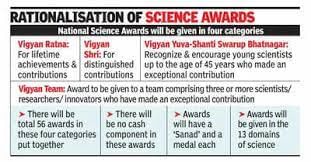
Why in News?
Recently, the Union government instituted the Rashtriya Vigyan Puraskar.
- Rashtriya Vigyan Puraskar includes 56 prizes to felicitate scientists, technologists and innovators.
- The 56 proposed awards are a stark reduction from the almost 300 science prizes that used to be given by Union Ministries.
- The awards will commence in 2024.
- The awards will be announced annually on May 11, which is National Technology Day.
- They will be awarded on National Space Day, August 23.
- They will be given by the President or the Vice President.
- Scientists/ technologists/innovators working in government, private sector organizations or any individual working outside any organization, who have made distinguished contributions in terms of path-breaking research or innovation or discovery in any field of science, technology, or technology-led- led innovation shall be eligible for the awards.
- People of Indian Origin staying abroad with exceptional contributions benefiting the Indian communities or society shall also be eligible for the awards.
Categories: 3 Vigyan Ratna, 25 Vigyan Shri, 25 Vigyan Yuva–Shanti Swarup Bhatnagar, and 3 Vigyan Team.
- Vigyan Ratna: will recognize the lifetime achievement of scientists.
- Vigyan Shri: will recognize distinguished contributions to a field.
- Vigyan Yuva Shanti Swarup Bhatnagar: will encourage young scientists who have made exceptional contributions in their field, and the Vigyan Team will recognize teams of three or more.
- All Awards will have a Sanad & a medal.
Source: The Hindu
GS-III
Prachand
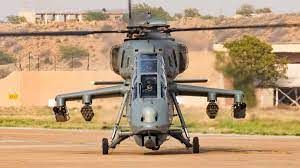
Why in News?
Army’s Light Combat Helicopter Prachand successfully carried out its inaugural firing recently.
- In an exclusive interview with All India Radio, the Director General of the Army Aviation Corps Lt Gen AK Suri underscored that with each passing year Army Aviation Corps is setting new milestones in terms of capability building and increasing its sphere of influence.
- One of the youngest corps of the Indian Army, Army Aviation was created as a separate arm on 1st November 1986.
- Designed and manufactured by: Hindustan Aeronautics Limited (HAL).
- It is multi-role and can perform roles of Combat Search and Rescue (CSAR), Destruction of Enemy Air Defence (DEAD) and Counter Insurgency (CI) operations.
- The LCH has been designed as a twin-engine.
- It is a dedicated combat helicopter of 5.8-ton class, thus categorized as light.
- It features a narrow fuselage and tandem one-behind-the-other configuration for the pilot and co-pilot.
- The co-pilot is also the Weapon Systems Operator (WSO).
- It has a maximum take-off weight of 5.8 tonnes, a maximum speed of 268 kilometres per hour, range of 550 kilometres.
- It has an endurance of over three hours and a service ceiling the maximum density altitude to which it can fly of 6.5 kilometres.
- LCH is powered by two French-origin Shakti engines manufactured by the HAL.
- The helicopter uses radar-absorbing material to lower radar signature and has a significantly crash-proof structure and landing gear.
- A pressurized cabin offers protection from nuclear, biological and chemical (NBC) contingencies.
- The LCH is the only attack helicopter in the world that can land and take off at an altitude of 5,000 metres (16,400 ft), which makes it ideal to operate in the high-altitude areas of the Siachen glacier.
Source: AIR
Delhi AQI worsens to ‘Severe Plus’
Subject: Economics
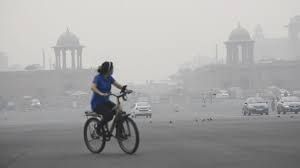
Why in News?
As Delhi-NCR and its environs grapple with worsening air pollution, the Air Quality Index (AQI) has gained prominence as a critical measure of air quality.
- AQI measures how safe the air around you is for breathing. Organizations that report AQI measure the density of various pollutants in the air (such as PM2.5, PM10, nitrogen dioxide, ozone, etc) at different monitoring stations.
- The widely-used National Air Quality Index (NAQI) given by the Central Pollution Control Board is a 24-hour average.
- Its unit is micrograms per cubic meter.
- A particular amount of one pollutant may not be as harmful as the same amount of another pollutant.
- So, each pollutant’s quantity in the air is adjusted to a common scale (say, 0 to 500) that works for all pollutants.
- Finally, the pollutant with the worst sub-index determines the AQI for that time and location.
Air Pollutants covered:
- Sulphur Dioxide (SO2)
- Nitrogen Dioxide (NO2),
- Particulate Matter (size less than 10 µm) or PM 10
- Particulate Matter (size less than 2.5 µm) or PM2.5
- Ozone (O3)
- Carbon Monoxide (CO)
- Ammonia (NH3)
(Pollutants that most of us NEVER heard of-)
- Lead
- Benzene (C6H6)
- Benzo(a)Pyrene (BaP)
- Arsenic(As)
- Nickel (Ni)
- Graded Response Action Plan (GRAP): AQI plays a pivotal role in shaping government policies to combat air pollution. When AQI levels in areas like Delhi-NCR deteriorate, emergency measures, such as Stage 3 of GRAP, are activated.
- Immediate Action: For instance, the recent dip in AQI to the ‘severe’ category prompted immediate actions. Diesel four-wheelers not meeting BS-VI compliance were prohibited, and truck entry into Delhi was restricted. Petrol cars continued to operate under regular conditions.
- The GRAP was conceived as a response to the alarming findings of a WHO study in 2014, which ranked Delhi as the most polluted city globally.
- In 2016, the Supreme Court (M. C. Mehta vs. Union of India Case) approved GRAP after multiple expert consultations.
- First GRAP was notified in January 2017 by the Ministry of Environment, Forest and Climate Change.
- Starting in 2021, the Commission for Air Quality Management in NCR & Adjoining Areas (CAQM) has taken over the responsibility of implementing GRAP.
- Prior to 2021, the Supreme Court-appointed EPCA would instruct states to enforce GRAP measures.
- In 2020, the EPCA was disbanded and substituted with the Commission for Air Quality Management (CAQM).
- The CAQM recommendations depend on the Air Quality Index (AQI) and meteorological predictions provided by the Indian Institute of Tropical Meteorology (IITM) and the India Meteorological Department (IMD).
| Air Quality Stage | Range | Measures to be implemented |
| Stage I (Poor) | 201-300 | Enforce NGT/Supreme Court’s order on over-aged diesel/petrol vehicles. |
| Stage II (Very Poor) | 301-400 | Implement rigorous actions to combat air pollution at identified hotspots. |
| Stage III (Severe) | 401-450 | Impose strict restrictions on BS III petrol and BS IV diesel vehicles. Suspend physical classes in schools for primary grade children up to Class 5 in certain areas. |
| Stage IV (Severe Plus) | >450 | Prohibit the entry of four-wheelers registered outside Delhi, except for electric vehicles, CNG vehicles, and BS-VI diesel vehicles. |
|
38 videos|5283 docs|1116 tests
|
FAQs on UPSC Daily Current Affairs- 4th November 2023 - Current Affairs & Hindu Analysis: Daily, Weekly & Monthly
| 1. What are the Taurid meteor showers? |  |
| 2. When do the Taurid meteor showers occur? |  |
| 3. How can one observe the Taurid meteor showers? |  |
| 4. Are the Taurid meteor showers visible worldwide? |  |
| 5. Are the Taurid meteor showers dangerous? |  |
















